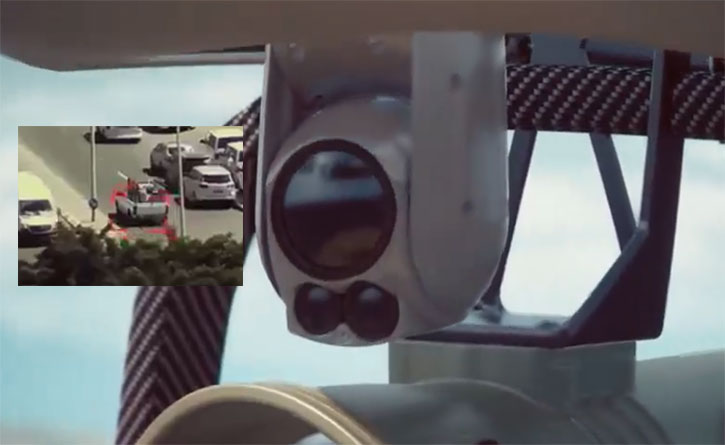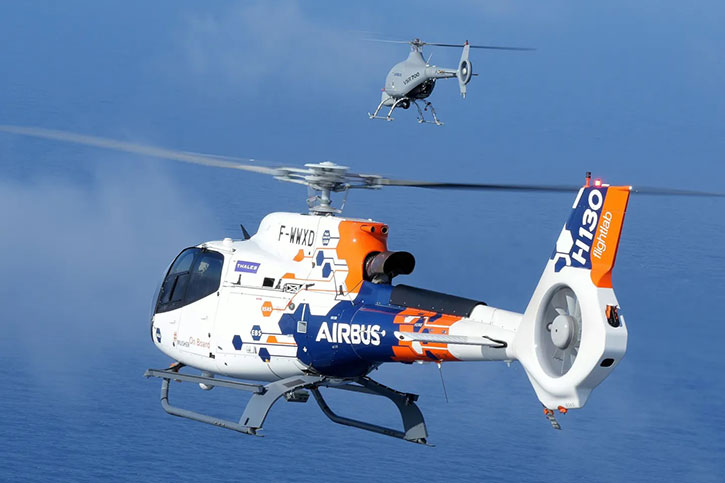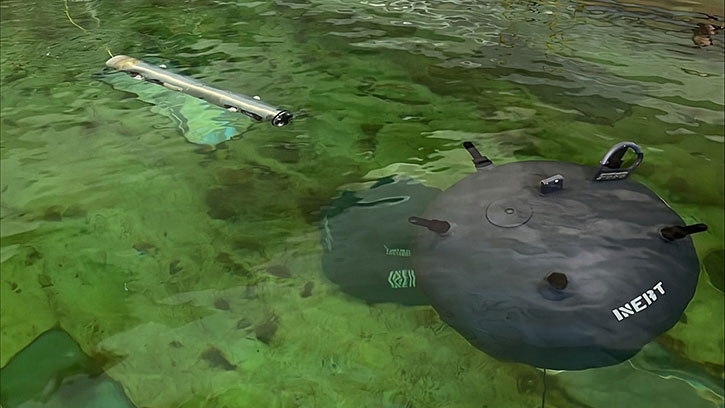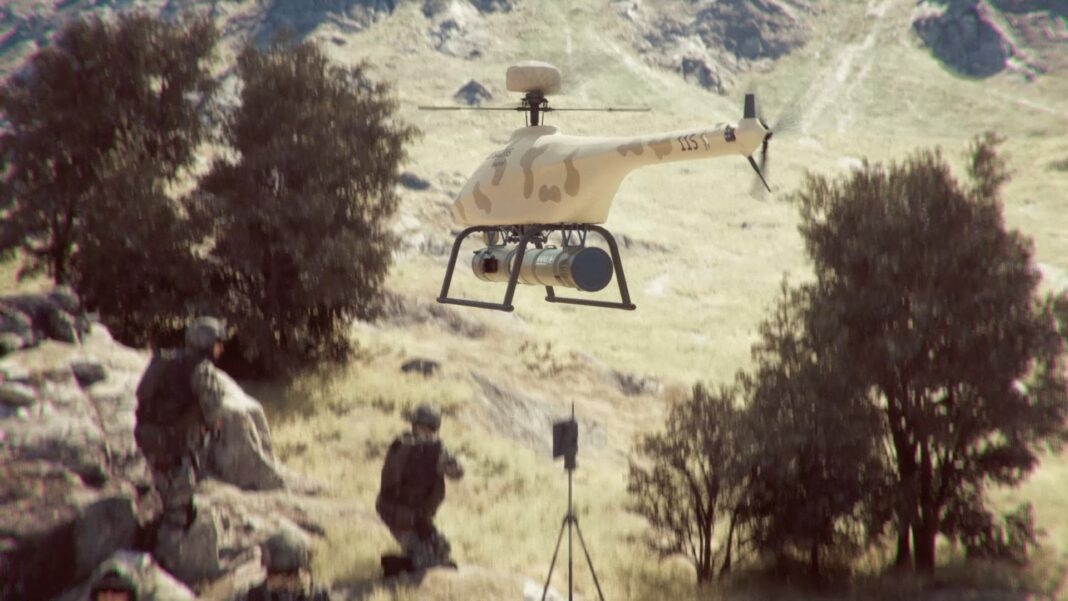Steadicopter is modifying its Golden Eagle Rotary Unmanned Aerial Systems (RUAS) to operate as an anti-tank and anti-material aerial system. The company is introducing the Golden Eagle Heavy Strike (HS) at AUSA 2024, armed with a Spike SR and Spike LR2 anti-tank Guided Missiles (ATGM). This new application is developed in collaboration with Rafael Advanced Defense Systems, the developer of the Spike missile.
Integrated with those missiles, the Golden Eagle HS integrates the Golden Eagle HS, which has a total takeoff weight of 50 kilograms. Encapsulated into its launcher container, Rafael’s Spike SR weighs 10 kg and can engage targets up to 2.5 kilometers away. It has a Fire and Forget guidance and uses a tandem warhead penetrating heavy armor. Spike LR2 weighs 13 kg, can extend engagement range to 5,500 meters, and has a multi-effect warhead, suitable for anti-armor, concrete penetration capability. The missile uses a fiber-optic link for two-way communications, enabling the operator to correct and retarget the missile in flight. According to the manufacturer, the missile can extend its range to 10,000 meters using an RF link.
Steadicopter unveiled another RUAV, the Golden Eagle LS, unveiled last year. It is equipped with the SmashDragon, a seven-kilogram remotely operated weapon station from Smartshooter. Compared with multirotor drones, Golden Eagle offers more efficient flight and hovering capability, with up to one hour of hovering and 1.20 hours of flight endurance. It can operate under high wind conditions and take off or land at a wind speed of 25 knots. Its datalink range is 150 km. The HS model’s performance may differ from the LS, due to the higher weight.
Like the Golden Eagle LS, the HS includes advanced sensor suites with high-definition day/night EO/IR payloads and target trackers. RAFAEL’s SightX AI technology can enhance this payload with target acquisition, tracking, and classification features optimized for the Spike weapon system. Thus, the system enables an individualized ID per object, ensuring continuous tracking even with temporary obstructions or loss of sight within the field of view and autonomously distinguishing between various targets, whether moving or stationary, human or vehicle-based.
The Golden Eagle HS can be operated in formations of several aerial vehicles, with each RUAV carrying its missile, enhancing operational effectiveness and maintaining strike capability against multiple objectives.

NextVision’s New AI-Powered Micro-Payload for Enhanced Situational Awareness
Drone payload specialist NextVision has announced the development of an AI-powered system designed to enhance situational awareness capabilities provided by its EO/IR payloads. The new technology integrates advanced artificial intelligence algorithms with drone-based imaging systems, enabling real-time analysis and interpretation of complex environments. The system’s key feature is its ability to process and analyze vast amounts of visual data collected by drones, providing operators with actionable insights and enhanced decision-making capabilities. By leveraging AI, NextVision’s technology can quickly identify and categorize objects, detect anomalies, and track movements in diverse scenarios, ranging from urban environments to remote terrains.

Andurill Introduces a Scout-Attack Drone Team – Bolt and Bolt-M
Anduril Industries has introduced the Bolt family of man-packable vertical take-off and landing (VTOL) autonomous systems designed to provide integrated, persistent awareness and lethality for tactical forces. The Bolt family addresses ground forces’ need for many low-cost, lightweight, man-portable, and reliable loitering munitions capable of delivering outsized performance without requiring specialized operators.
The base configuration Bolt is designed for man-packable ISR and search and rescue. Bolt-M, the munition variant, is designed as loitering precision firepower. Unlike FPV drones widely used in the Ukraine War, Bolt M leverages onboard software to automate the flight behaviors required to track and strike a target accurately while providing human operators with four simple decisions: where to look, what to follow, how to engage, and when to attack. Mission endurance is more than 40 minutes and 20 kilometers in range; bolt-m can significantly extend the reach of dismounted forces. Preparations for flight take about five minutes and require no ground equipment or special tools. If the weapon has not engaged a target, it can be safely disarmed and retrieved for further use. Preparations for flight take about five minutes and require no ground equipment or special tools.
With a three-pound munition payload capacity, Bolt-M delivers devastating effects against static or moving ground-based targets. Compatible with a range of Anduril and third-party warheads, including munition developed in collaboration with Kraken Kinetics, Bolt M enables operators to select anti-personnel or anti-materiel effects and is also effective against light vehicles, dismounted personnel, trenches, and more.
Powered and controlled by a tactical version of Anduril’s Lattice software platform, Bolt-M is equipped with advanced onboard Artificial Intelligence and Machine Learning (AI/ML) software to automate the flight behaviors required to find, track, and strike dynamic targets. With autonomous waypoint navigation that can be modified as needed through a simple touchscreen interface, Bolt-M allows operators to manage complex tasks rather than focusing on basic navigation.
Once a target is identified in Lattice, an operator can draw a bounding box around any visual target for Bolt-M to follow, specify a standoff position for Bolt-M to maintain, tasking the system to stalk the target from beyond the visual or acoustic detection range even as the target moves and is occluded. When it’s time to strike, an operator can define the engagement angle to ensure the most effective strike. At the same time, onboard vision and guidance algorithms maintain terminal guidance even if connectivity is lost with the operator.
As a software-defined capability, the Bolt family of systems both benefits from and contributes to the broader ecosystem of capabilities integrated through Lattice, sharing sensor, targeting, and other data across Anduril and third-party platforms to provide commanders with a comprehensive picture of the battlespace and act accordingly.
DoD Seeks Long-Range One-Way UAS Platforms for Extended Precision Effects
The US Department of Defense (DoD) is soliciting commercial solutions for ground-launched, one-way unmanned aerial systems (UAS) capable of operating at ranges from 50 to 300+ kilometers. This initiative addresses the asymmetric impact of low-cost, one-way UAS on modern battlefields and enhances the DoD’s ability to employ precision effects at extended ranges.
The UAS platform should be able to carry a payload of 10 kg (preferably 25+ kg) and operate in disrupted, disconnected, intermittent, and low-bandwidth (DDIL) environments, as well as in Global Navigation Satellite System (GNSS) denied conditions. Key requirements include quick launch capabilities, low-altitude autonomous flight, and the ability to function beyond the line of sight.
Submissions should detail the proposed UAS’s physical and performance characteristics, including its ground launch mechanism, operational limitations, and launch rate. The platform must be challenging to detect and track by broad-area search systems. Additionally, the UAS should be capable of executing its mission without continuous operator communication, though multiple pathways for two-way communications are desired. The DoD seeks solutions with intuitive mission planning software that can integrate with other platforms. The UAS should allow for rapid integration of third-party software and hardware components, utilizing open interfaces for seamless integration. Proprietary systems requiring vendor-specific licensing are not permitted.

Airbus and Partners Showcase Manned-Unmanned Teaming System for Helicopters
Airbus Helicopters and its European partners Leonardo, Thales, Indra, and ONERA have successfully demonstrated a manned-unmanned teaming (MUM-T) system as part of the MUSHER project, which the European Union funds. The demonstration, which took place in France and Italy from September 30 to October 9, 2024, involved multiple manned helicopters and unmanned aerial systems (UAS) connected to a single MUM-T network.
The experiment showcased various scenarios, including an anti-piracy mission, to demonstrate levels of interoperability (LOI) 2 to 4. These levels ranged from direct receipt of UAS data by manned helicopters and ground stations to the control and monitoring of UAS from helicopters. The demonstration proved that manned helicopters and UAS from different companies and countries operating in distant areas could be integrated within a single MUM-T system.
Airbus deployed its H130 FlightLab as a manned platform and the VSR700 UAS for the demonstration, while Leonardo contributed a helicopter and an optionally piloted vehicle. Other partners included Thales, who provided supervision and mission debriefing stations; Space Applications Services for mission preparation; Indra for simulation activities; and ONERA for crew workload studies.
MUSHER is a project launched in the frame of the European Defence Industrial Development Programme (EDIDP) launched by the European Commission in December 2021. The project aims to develop a generic European MUM-T system that can operate robustly in multiple environments (civil, military, or mixed) while reducing the crew’s workload and delivering maximum operational capacity.
Philippine Navy to Establish USV Unit for Enhanced Maritime Surveillance
The Philippine Navy is set to create a new unmanned surface vessel (USV) unit to bolster its maritime domain awareness capabilities. Flag Officer-in-Command Vice Adm. Toribio Adaci confirmed the existence of this new drone unit during an interview at the 5th Asia Defense and Security Exhibition (ADAS). The primary mission of these USVs will be to improve the navy’s ability to monitor Philippine waters, particularly in the face of increasing tensions with China in the South China Sea. This initiative is part of Horizon 3, the final phase of Manila’s military modernization program, which also prioritizes surface vessels and anti-submarine capabilities. The USV unit is expected to support the concept of Manned-Unmanned Teaming, enhancing the effectiveness of existing warships. In addition to the USV unit, the Philippine Navy plans to acquire aircraft for maritime domain awareness and upgrade its littoral monitoring stations scattered throughout the country’s 7,641 islands.

Raytheon Completes Testing of Barracuda Mine Neutralization System
Raytheon has successfully conducted hydrodynamic testing for the Barracuda Mine Neutralization System at the US Naval Surface Warfare Center Carderock Division. This milestone brings the program closer to operational testing. Barracuda is the U.S. Navy’s program of record for next-generation mine neutralization. It is a semi-autonomous system that uses sonar and camera systems to locate and neutralize undersea mine threats.
The tests involved a production representative unit operating in various simulated ocean conditions, including different sea states and water currents. The Barracuda system showcased its ability to detect, track, and maintain position on a target autonomously, marking the first time Raytheon has performed such testing with the underwater vehicle. This achievement is crucial for the system’s development as it moves towards meeting operational requirements for the U.S. Navy’s next-generation mine neutralization program.
Raytheon was first awarded a contract for Barracuda in 2018. The program completed its critical design review in March 2023 and has entered its qualification testing phase. In July 2023, Raytheon was awarded a contract to deliver engineering development model units to the U.S. Navy. The program will go into Low-Rate Initial Production in 2027.
More news this week:




















